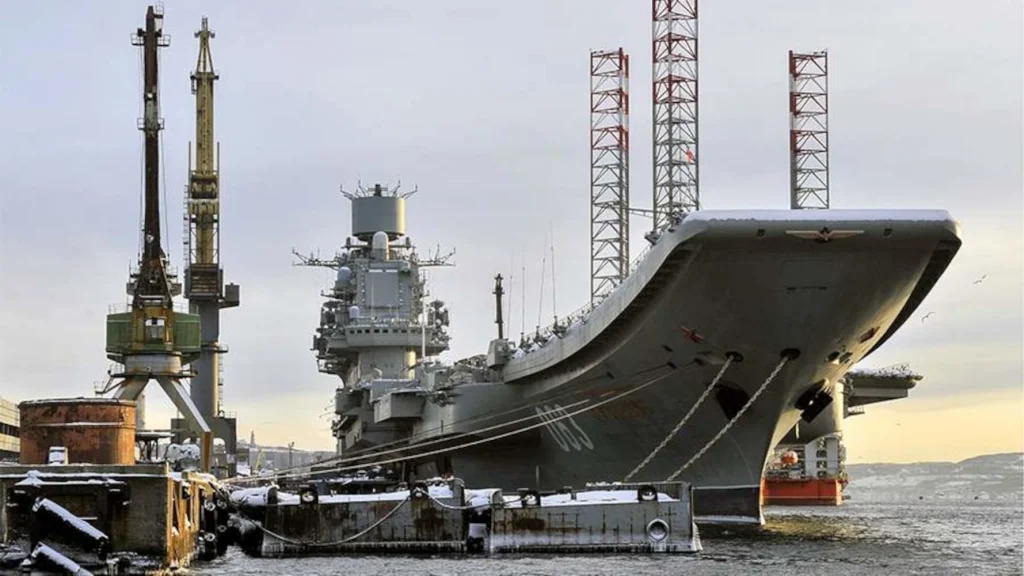Admiral Kuznetsov is the only aircraft carrier that Russia inherited from an extensive modernization program of the Soviet fleet. Originally built as a cruiser, the ship was turned into an aircraft carrier with several compromises: the vessel is heavily armed, but her air group is limited, and her combat readiness is low.
Admiral Kuznetsov carries 12 P-700 Granit attack missiles with a range of 500 km, which are rightfully called aircraft carrier destroyers. At the same time, the air fleet located onboard is “much weaker than its Western contemporaries, maximum 15-20 aircraft, and is predominantly for defensive purpose.
The ship’s air group comprises Su-33 and MiG-29K fighters, which are equipped with powerful enough engines to take off from a ski jump. However, they cannot take off with a large load of equipment. Only a few of them were built – about three dozen Su-33s and just 15 MiG-29K’s.

The carrier-based fighters rarely take to the air. For example, according to the Pentagon, during the deployment of Admiral Kuznetsov in Syria in 2016, only 154 sorties were made within two months, which translates to just 3 per day, which is 10-15 times less than that of a modern aircraft carrier.
Low sorties negatively affect pilots’ qualifications, which, in turn, leads to increased accident rates. During the Syrian operation, three aircraft were lost. The ship’s deployment in northern latitudes also prevents regular flights due to ice cover on the deck and lack of sunlight. More than six years have passed since the last mission of Admiral Kuznetsov, which continues to be under repair. (Also read USC will transfer the aircraft carrier “Admiral Kuznetsov” to the Russian Navy in 2023)
The ageing air group’s usefulness is doubtful. The service life of the Su-33 is expiring, and they have low combat effectiveness.
India, which has deployed Mig-29K’s onboard INS Vikramaditya, is looking for alternative aircraft for the upcoming carrier INS Vikrant. (Also read Testing for three key challenges – Rafale M image shows full load during the Indian Aircraft Carrier Vikrant qualification trials, and India could lease Rafale M from France to jumpstart INS Vikrant airwing)
Su-33KUB – the forgotten Russian combat training carrier-based fighter
The fourth-generation Russian combat training carrier-based fighter Su-33KUB was one of the most interesting combat aircraft of its time.
The first flight of Su-33KUB took place on April 29, 1999, in Zhukovsky near Moscow. The aircraft was lifted into the air by a crew consisting of test pilots from the Sukhoi Design Bureau, Viktor Pugachev and Sergei Melnikov. On April 6. they landed the Su-33KUB on the deck of the Russian aircraft carrier Admiral of the Fleet of the Soviet Union ‘Kuznetsov’.
As you might guess, the aircraft was created based on the Su-33 carrier-based fighter. However, the new aircraft had one significant distinguishing feature: the side-by-side crew arrangement, which was non-standard for combat training aircraft. It improved the interaction of pilots during the flight and provided a better forward-down view than traditional combat training aircraft, which is very important for landing on the deck of an aircraft carrier. In addition, one 21-inch and four 15-inch colour LCD monitors appeared on the dashboard of the unique cabin.
The Su-33KUB, like its progenitor, had a front horizontal tail, that is, a horizontally located airfoil. The wing differed from that of the Su-33 as it was integrated with microprocessors and electronic sensors built into the skin. Another distinguishing feature of the Su-33KUB is the ability to use flaps throughout the flight, not just during takeoff and landing. And this made it possible to maintain the aerodynamic characteristics of the aircraft. The fuel consumption was reduced by 15-20%, and the wingspan was increased by 50%. This made the Su-33KUB a significantly more manoeuvrable aircraft, which turned out to be extremely important when landing on the deck of a ship.

The AL-31K engine on the Su-33KUB is a version of the famous AL-31F modified for use in the marine environment. Later, plans appeared to install the AL-31FP engine with thrust vector control on the fighter, which would significantly increase the aircraft’s manoeuvrability. But this plan, unfortunately, was never translated into reality.
The aircraft was equipped with the same N011 Bars phased array radar as the Su-30MK. The radar operates in X and L bands, provides an overview of air space, automatic detection and tracking of targets, including during close combat and automatic radar mapping of the area. The radar guides missiles R-77, R-73, R-27 and KH-31. The radar detection range for fighters is 150 kilometres, for large air targets 400 kilometres, and 200 kilometres for targets on the sea surface. Thanks to this, the Su-33KUB could simultaneously track 15 and attack six targets at a time, and the optical aiming system can detect objects within a radius of 50 kilometres.
The weapon system includes a GSh-30-1 cannon and ten external points under the wing and belly. GSh-30-1 cannon is the first mass-produced Soviet aircraft gun with liquid cooling. The casing of the gun holds 0.7 litres of water. When the barrel is heated during firing, the water turns into steam and passes through the screw groove on the barrel, cooling it, before being released into the air.
In 1999, the Su-33KUB was undoubtedly a potent, multi-purpose carrier-based aircraft. Compared to its predecessor, the Su-33 Flanker-D, it had qualitatively improved mobility, automation, maintainability and versatility. The Russian Navy hoped that it would join the fleet as soon as possible and replace all the Su-33s in service. However, cheaper Mig-29K and MIG-29KUB fighters were built based on the Indian Navy contract. Nevertheless, the Su-33KUB could be called an unusual aircraft, fully justifying the attention it received.
